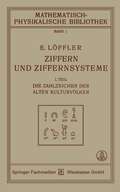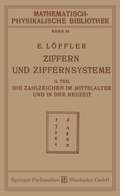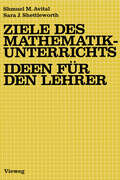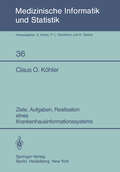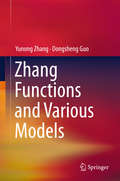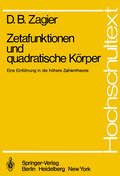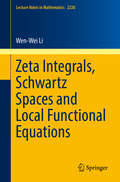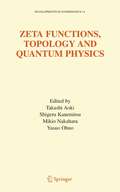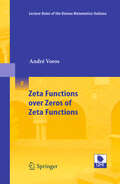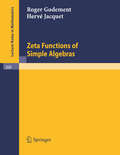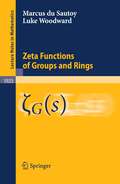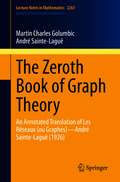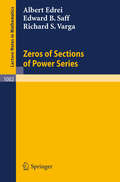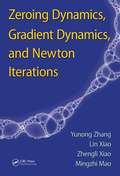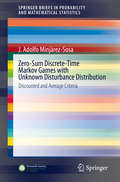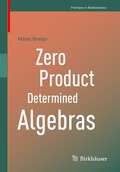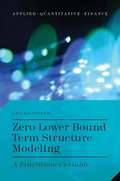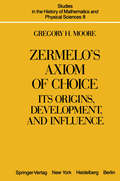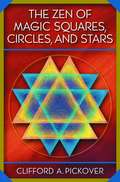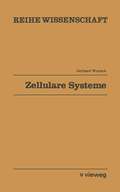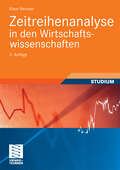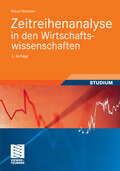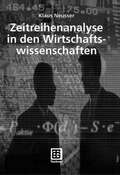- Table View
- List View
Ziffern und Ziffernsysteme: I. Teil Die Zahlzeichen der Alten Kulturvölker (Mathematisch-physikalische Bibliothek)
by Dr. Eugen LöfflerDieser Buchtitel ist Teil des Digitalisierungsprojekts Springer Book Archives mit Publikationen, die seit den Anfängen des Verlags von 1842 erschienen sind. Der Verlag stellt mit diesem Archiv Quellen für die historische wie auch die disziplingeschichtliche Forschung zur Verfügung, die jeweils im historischen Kontext betrachtet werden müssen. Dieser Titel erschien in der Zeit vor 1945 und wird daher in seiner zeittypischen politisch-ideologischen Ausrichtung vom Verlag nicht beworben.
Ziffern und Ziffernsysteme: II. Teil die Zahlzeichen im Mittelalter und in der Neuzeit (Mathematisch-physikalische Bibliothek)
by Eugen LöfflerDieser Buchtitel ist Teil des Digitalisierungsprojekts Springer Book Archives mit Publikationen, die seit den Anfängen des Verlags von 1842 erschienen sind. Der Verlag stellt mit diesem Archiv Quellen für die historische wie auch die disziplingeschichtliche Forschung zur Verfügung, die jeweils im historischen Kontext betrachtet werden müssen. Dieser Titel erschien in der Zeit vor 1945 und wird daher in seiner zeittypischen politisch-ideologischen Ausrichtung vom Verlag nicht beworben.
Ziele des Mathematikunterrichts — Ideen für den Lehrer: Ideen für d. Lehrer
by Shmuel M. Avital Sara J. ShettleworthZiele, Aufgaben, Realisation eines Krankenhausinformationssystems (Medizinische Informatik, Biometrie und Epidemiologie #36)
by C. O. KöhlerZhang Functions and Various Models
by Yunong Zhang Dongsheng GuoThis book focuses on solving different types of time-varying problems. It presents various Zhang dynamics (ZD) models by defining various Zhang functions (ZFs) in real and complex domains. It then provides theoretical analyses of such ZD models and illustrates their results. It also uses simulations to substantiate their efficacy and show the feasibility of the presented ZD approach (i.e., different ZFs leading to different ZD models), which is further applied to the repetitive motion planning (RMP) of redundant robots, showing its application potential.
Zetafunktionen und quadratische Körper: Eine Einführung in die höhere Zahlentheorie (Hochschultext)
by D.B. ZagierZeta Integrals, Schwartz Spaces and Local Functional Equations (Lecture Notes in Mathematics #2228)
by Wen-Wei LiThis book focuses on a conjectural class of zeta integrals which arose from a program born in the work of Braverman and Kazhdan around the year 2000, the eventual goal being to prove the analytic continuation and functional equation of automorphic L-functions. Developing a general framework that could accommodate Schwartz spaces and the corresponding zeta integrals, the author establishes a formalism, states desiderata and conjectures, draws implications from these assumptions, and shows how known examples fit into this framework, supporting Sakellaridis' vision of the subject. The collected results, both old and new, and the included extensive bibliography, will be valuable to anyone who wishes to understand this program, and to those who are already working on it and want to overcome certain frequently occurring technical difficulties.
Zeta Functions, Topology and Quantum Physics (Developments in Mathematics #14)
by Takashi Aoki Shigeru Kanemitsu Mikio Nakahara Yasuo OhnoThis volume contains papers by invited speakers of the symposium "Zeta Functions, Topology and Quantum Physics" held at Kinki U- versity in Osaka, Japan, during the period of March 3-6, 2003. The aims of this symposium were to establish mutual understanding and to exchange ideas among researchers working in various fields which have relation to zeta functions and zeta values. We are very happy to add this volume to the series Developments in Mathematics from Springer. In this respect, Professor Krishnaswami Alladi helped us a lot by showing his keen and enthusiastic interest in publishing this volume and by contributing his paper with Alexander Berkovich. We gratefully acknowledge financial support from Kinki University. We would like to thank Professor Megumu Munakata, Vice-Rector of Kinki University, and Professor Nobuki Kawashima, Director of School of Interdisciplinary Studies of Science and Engineering, Kinki Univ- sity, for their interest and support. We also thank John Martindale of Springer for his excellent editorial work.
Zeta Functions over Zeros of Zeta Functions (Lecture Notes of the Unione Matematica Italiana #8)
by André VorosZeta Functions of Simple Algebras (Lecture Notes in Mathematics #260)
by Roger Godement Herve JacquetZeta Functions of Groups and Rings (Lecture Notes in Mathematics #1925)
by Marcus du Sautoy Luke WoodwardZeta functions have been a powerful tool in mathematics over the last two centuries. This book considers a new class of non-commutative zeta functions which encode the structure of the subgroup lattice in infinite groups. It explores the analytic behavior of these functions together with an investigation of functional equations. The book examines many important examples of zeta functions, providing an important database of explicit examples and methods for calculation.
The Zeroth Book of Graph Theory: An Annotated Translation of Les Réseaux (ou Graphes)—André Sainte-Laguë (1926) (Lecture Notes in Mathematics #2261)
by Martin Charles Golumbic André Sainte-LaguëMarking 94 years since its first appearance, this book provides an annotated translation of Sainte-Laguë's seminal monograph Les réseaux (ou graphes), drawing attention to its fundamental principles and ideas. Sainte-Laguë's 1926 monograph appeared only in French, but in the 1990s H. Gropp published a number of English papers describing several aspects of the book. He expressed his hope that an English translation might sometime be available to the mathematics community. In the 10 years following the appearance of Les réseaux (ou graphes), the development of graph theory continued, culminating in the publication of the first full book on the theory of finite and infinite graphs in 1936 by Dénes König. This remained the only well-known text until Claude Berge's 1958 book on the theory and applications of graphs. By 1960, graph theory had emerged as a significant mathematical discipline of its own. This book will be of interest to graph theorists and mathematical historians.
Zeros of Sections of Power Series (Lecture Notes in Mathematics #1002)
by A. Edrei E. B. Saff R. S. VargaZeroing Dynamics, Gradient Dynamics, and Newton Iterations
by Yunong Zhang Lin Xiao Zhengli Xiao Mingzhi MaoNeural networks and neural dynamics are powerful approaches for the online solution of mathematical problems arising in many areas of science, engineering, and business. Compared with conventional gradient neural networks that only deal with static problems of constant coefficient matrices and vectors, the authors’ new method called zeroing dynamics solves time-varying problems. Zeroing Dynamics, Gradient Dynamics, and Newton Iterations is the first book that shows how to accurately and efficiently solve time-varying problems in real-time or online using continuous- or discrete-time zeroing dynamics. The book brings together research in the developing fields of neural networks, neural dynamics, computer mathematics, numerical algorithms, time-varying computation and optimization, simulation and modeling, analog and digital hardware, and fractals. The authors provide a comprehensive treatment of the theory of both static and dynamic neural networks. Readers will discover how novel theoretical results have been successfully applied to many practical problems. The authors develop, analyze, model, simulate, and compare zeroing dynamics models for the online solution of numerous time-varying problems, such as root finding, nonlinear equation solving, matrix inversion, matrix square root finding, quadratic optimization, and inequality solving.
Zero to Hero in Cryptocurrency Trading: Learn to trade on a centralized exchange, understand trading psychology, and implement a trading algorithm
by Bogdan VaidaGo from the bare basics to implementing your own automatic trading algorithm and become a cryptocurrency trading proKey FeaturesExcel at crypto trading with structured methodologies, practical examples, and real-time trading scenariosGo from the theoretical know-how to developing and testing your own strategyTransform manual trades into an automated algorithm for nonstop tradesPurchase of the print or Kindle book includes a free PDF eBookBook DescriptionIn today's fast-paced digital age, cryptocurrencies have emerged as a revolutionary financial asset class, capturing the attention of investors and traders worldwide. However, navigating the world of cryptocurrency trading can be overwhelming for beginners. Zero to Hero in Cryptocurrency Trading acts as a guiding light to navigate this complex realm. This comprehensive guide to cryptocurrency trading empowers you to go from a novice trader to a proficient investor by helping you implement your own trading strategy. As you progress, you’ll gain structured trading knowledge through hands-on examples and real-time scenarios, bolstered by trading psychology and money management techniques. You’ll be able to automate your manual trades with an algorithm that works even while you sleep. You’ll also benefit from interactive teaching methods, including screenshots, charts, and drawings to help decode market operations and craft your unique edge in the dynamic crypto world. As an added bonus, you’ll receive ready-to-use templates to identify useful indicators, test your strategy, and even maintain a trading journal. By the end of this book, you’ll be well-equipped to trade cryptocurrencies and automate manual trading to give you an edge in the markets.What you will learnMaster trading psychology and prevent emotions from sabotaging tradesManage risks by identifying and tailoring specific risk profilesInterpret, assess, and integrate technical indicators in your tradingGet to grips with trading on a centralized exchangeGet a deeper understanding of risk and money managementGain an edge by identifying trading patternsAutomate the patterns into a strategy for a bot that operates 24/7Who this book is forThis book is for finance and investment professionals, crypto market enthusiasts, and anyone new to trading who wants to kickstart their cryptocurrency trading journey. A basic understanding of cryptocurrencies is a must, but prior trading experience is not necessary.
Zero-Sum Discrete-Time Markov Games with Unknown Disturbance Distribution: Discounted and Average Criteria (SpringerBriefs in Probability and Mathematical Statistics)
by J. Adolfo Minjárez-SosaThis SpringerBrief deals with a class of discrete-time zero-sum Markov games with Borel state and action spaces, and possibly unbounded payoffs, under discounted and average criteria, whose state process evolves according to a stochastic difference equation. The corresponding disturbance process is an observable sequence of independent and identically distributed random variables with unknown distribution for both players. Unlike the standard case, the game is played over an infinite horizon evolving as follows. At each stage, once the players have observed the state of the game, and before choosing the actions, players 1 and 2 implement a statistical estimation process to obtain estimates of the unknown distribution. Then, independently, the players adapt their decisions to such estimators to select their actions and construct their strategies. This book presents a systematic analysis on recent developments in this kind of games. Specifically, the theoretical foundations on the procedures combining statistical estimation and control techniques for the construction of strategies of the players are introduced, with illustrative examples. In this sense, the book is an essential reference for theoretical and applied researchers in the fields of stochastic control and game theory, and their applications.
Zero Product Determined Algebras (Frontiers in Mathematics)
by Matej BrešarThis book provides a concise survey of the theory of zero product-determined algebras, which has been developed over the last 15 years. It is divided into three parts. The first part presents the purely algebraic branch of the theory, the second part presents the functional analytic branch, and the third part discusses various applications. The book is intended for researchers and graduate students in ring theory, Banach algebra theory, and nonassociative algebra.
Zero Lower Bound Term Structure Modeling: A Practitioner’s Guide (Applied Quantitative Finance)
by L. KrippnerNominal yields on government debt in several countries have fallen very near their zero lower bound (ZLB), causing a liquidity trap and limiting the capacity to stimulate economic growth. This book provides a comprehensive reference to ZLB structure modeling in an applied setting.
Zermelo’s Axiom of Choice: Its Origins, Development, and Influence (Studies in the History of Mathematics and Physical Sciences #8)
by G.H. MooreThis book grew out of my interest in what is common to three disciplines: mathematics, philosophy, and history. The origins of Zermelo's Axiom of Choice, as well as the controversy that it engendered, certainly lie in that intersection. Since the time of Aristotle, mathematics has been concerned alternately with its assumptions and with the objects, such as number and space, about which those assumptions were made. In the historical context of Zermelo's Axiom, I have explored both the vagaries and the fertility of this alternating concern. Though Zermelo's research has provided the focus for this book, much of it is devoted to the problems from which his work originated and to the later developments which, directly or indirectly, he inspired. A few remarks about format are in order. In this book a publication is indicated by a date after a name; so Hilbert 1926, 178 refers to page 178 of an article written by Hilbert, published in 1926, and listed in the bibliography.
The Zen of Magic Squares, Circles, and Stars: An Exhibition of Surprising Structures across Dimensions
by Clifford A. PickoverHumanity's love affair with mathematics and mysticism reached a critical juncture, legend has it, on the back of a turtle in ancient China. As Clifford Pickover briefly recounts in this enthralling book, the most comprehensive in decades on magic squares, Emperor Yu was supposedly strolling along the Yellow River one day around 2200 B.C. when he spotted the creature: its shell had a series of dots within squares. To Yu's amazement, each row of squares contained fifteen dots, as did the columns and diagonals. When he added any two cells opposite along a line through the center square, like 2 and 8, he always arrived at 10. The turtle, unwitting inspirer of the ''Yu'' square, went on to a life of courtly comfort and fame. Pickover explains why Chinese emperors, Babylonian astrologer-priests, prehistoric cave people in France, and ancient Mayans of the Yucatan were convinced that magic squares--arrays filled with numbers or letters in certain arrangements--held the secret of the universe. Since the dawn of civilization, he writes, humans have invoked such patterns to ward off evil and bring good fortune. Yet who would have guessed that in the twenty-first century, mathematicians would be studying magic squares so immense and in so many dimensions that the objects defy ordinary human contemplation and visualization? Readers are treated to a colorful history of magic squares and similar structures, their construction, and classification along with a remarkable variety of newly discovered objects ranging from ornate inlaid magic cubes to hypercubes. Illustrated examples occur throughout, with some patterns from the author's own experiments. The tesseracts, circles, spheres, and stars that he presents perfectly convey the age-old devotion of the math-minded to this Zenlike quest. Number lovers, puzzle aficionados, and math enthusiasts will treasure this rich and lively encyclopedia of one of the few areas of mathematics where the contributions of even nonspecialists count.
The Zen of Magic Squares, Circles, and Stars: An Exhibition of Surprising Structures across Dimensions
by Clifford A. PickoverHumanity's love affair with mathematics and mysticism reached a critical juncture, legend has it, on the back of a turtle in ancient China. As Clifford Pickover briefly recounts in this enthralling book, the most comprehensive in decades on magic squares, Emperor Yu was supposedly strolling along the Yellow River one day around 2200 B.C. when he spotted the creature: its shell had a series of dots within squares. To Yu's amazement, each row of squares contained fifteen dots, as did the columns and diagonals. When he added any two cells opposite along a line through the center square, like 2 and 8, he always arrived at 10. The turtle, unwitting inspirer of the ''Yu'' square, went on to a life of courtly comfort and fame. Pickover explains why Chinese emperors, Babylonian astrologer-priests, prehistoric cave people in France, and ancient Mayans of the Yucatan were convinced that magic squares--arrays filled with numbers or letters in certain arrangements--held the secret of the universe. Since the dawn of civilization, he writes, humans have invoked such patterns to ward off evil and bring good fortune. Yet who would have guessed that in the twenty-first century, mathematicians would be studying magic squares so immense and in so many dimensions that the objects defy ordinary human contemplation and visualization? Readers are treated to a colorful history of magic squares and similar structures, their construction, and classification along with a remarkable variety of newly discovered objects ranging from ornate inlaid magic cubes to hypercubes. Illustrated examples occur throughout, with some patterns from the author's own experiments. The tesseracts, circles, spheres, and stars that he presents perfectly convey the age-old devotion of the math-minded to this Zenlike quest. Number lovers, puzzle aficionados, and math enthusiasts will treasure this rich and lively encyclopedia of one of the few areas of mathematics where the contributions of even nonspecialists count.
Zeitreihenanalyse in den Wirtschaftswissenschaften (Studienbücher Wirtschaftsmathematik)
by Klaus NeusserOb Kursentwicklungen von Aktien oder Anleihen, die Entwicklung des Bruttoinlandsproduktes, die Inflationsrate oder die Arbeitslosenquote, die Wirtschaftsseiten der Zeitungen sind voll von Zeitreihen. Wie man solche Zeitreihen analysiert, Muster und Regelmäßigkeiten erkennt und Prognosen für die zukünftige Entwicklung erstellt, zeigt Ihnen dieses Buch. Der Text der 2. Auflage wurde gründlich überarbeitet und ein Kapitel über den "Kalman Filter" wurde hinzugefügt. Das Buch ist lernfreundlich aufbereitet und enthält Aufgaben mit Lösungen.
Zeitreihenanalyse in den Wirtschaftswissenschaften (Studienbücher Wirtschaftsmathematik)
by Klaus NeusserOb Kursentwicklungen von Aktien oder Anleihen, die Entwicklung des Bruttoinlandsproduktes, die Inflationsrate oder die Arbeitslosenquote, die Wirtschaftsseiten der Zeitungen sind voll von Zeitreihen. Wie man solche Zeitreihen analysiert, Muster und Regelmäßigkeiten erkennt und Prognosen für die zukünftige Entwicklung erstellt, zeigt Ihnen dieses Buch. Der Text der 3. Auflage wurde gründlich überarbeitet und ein Kapitel über die Analyse von Zeitreihen im Frequenzbereich hinzugefügt.
Zeitreihenanalyse in den Wirtschaftswissenschaften (Studienbücher Wirtschaftsmathematik)
by Klaus NeusserOb Kursentwicklungen von Aktien oder Anleihen, die Entwicklung des Bruttoinlandsproduktes, die Inflationsrate oder die Arbeitslosenquote, die Wirtschaftsseiten der Zeitungen sind voll von Zeitreihen. Wie man solche Zeitreihen analysiert, Muster und Regelmäßigkeiten erkennt und Prognosen für die zukünftige Entwicklung erstellt, zeigt Ihnen dieses Buch.
